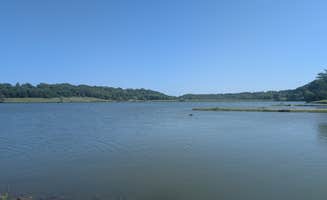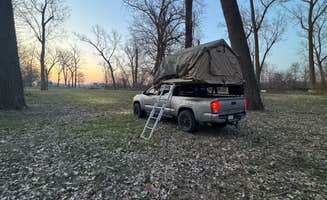Dispersed camping near Forest City, Missouri offers primitive wilderness experiences across several conservation areas and state fishing lakes within a 30-mile radius. The region sits in the Missouri River floodplain, creating diverse wetland habitats amid rolling hills. Most sites lack developed facilities and require campers to bring all necessary supplies including drinking water and waste disposal containers.
What to do
Fishing access points: Elrod Mill Access provides secluded fishing opportunities without established campsites. "Fishing access is available as well, which makes it a nice combination of camping and recreation. Overall, Elrod Mill is best suited for folks who want a primitive camping experience and don't mind roughing it a little for the sake of solitude," notes Sayler O. about this Elrod Mill Access location.
Bird watching: Several clearings near waterways create optimal bird watching conditions during spring and fall migrations. "This spot would be great for bird watchers," confirms Donner N. about the natural areas at Hoot Owl Bend, adding useful seasonal context about mulberry trees: "One of those trees in a mulberry, don't put your tent under it you will have mulberries dropping on you in July."
Wildlife observation: Nocturnal animal activity provides opportunities for wildlife enthusiasts willing to camp overnight. Carter G. describes the authentic wilderness experience: "I did hear animals huffing and saw some shadows run next to the truck at like 2am haha." Nighttime wildlife viewing requires proper safety precautions including secure food storage.
What campers like
Solitude and quietness: The limited development around Forest City creates exceptionally peaceful camping conditions, particularly at night. William M. describes the camping atmosphere at Atchison State Fishing Lake: "We're the only ones camping here. Some people come to fish during the day but it's dead at night. Clean pit toilets. Will definitely be back."
Multiple fishing piers: Lake access points feature several structures for anglers with varying water depths. Rick M. notes the specific location details: "The website actually forbids anybody camping around the cabin, so you need to use the campsites directly to the west, where there's a bunch of piers, sites, and bathrooms."
Natural clearings for tent setup: The undeveloped nature of sites offers flexible camping setups in natural openings. Donner N. provides practical details: "A nice little clearing easy to set up a tent in. There seems to be some private RV camping nearby which I was unsure about but they never came and bothered me."
What you should know
Access confusion and boundaries: Many rustic camping areas near Forest City border private property with unclear demarcation. "Was confused at first because there was a private road sign near the turn off, but after some looking it does look like it's a legit spot to camp," explains Carter G., confirming that careful navigation is required.
Stay duration limits: Conservation areas enforce different camping duration rules than standard national forest dispersed sites. Rick M. specifically mentions that "The management guy here is pretty cool and he let me know that it's a 7 day stay not 14."
Vegetation hazards: Natural growth includes stinging nettle in some waterside paths. According to one camper: "There is a nice walk towards the water, just wear pants and closed shoes to avoid the stinging nettle."
Potential overnight restrictions: Some conservation areas post closure times that conflict with overnight camping. Gordy Y. warns: "It seems like a bad place to park for the night; sign says area closed 10pm-4am, so camping of any kind seems unallowed."
Tips for camping with families
Toilet facilities: Plan bathroom arrangements carefully as most sites lack sanitation facilities. "Clean pit toilets" are available at limited locations according to William M., making these sites better options for families with young children.
Road conditions assessment: Access roads vary significantly in steepness and maintenance. Rick M. provides specific access information about one approach: "We drove down 322nd Rd. to get to our site near the bathrooms across from the maintenance building. That road is gradual enough that I was able to get my short bus down it safely without tipping over."
Wildlife preparation: Prepare children for potential wildlife encounters with proper food storage and noise precautions. Multiple campers report nocturnal animal activity, requiring appropriate preparation for overnight stays with children.
Tips from RVers
Vehicle size limitations: Smaller RVs and converted vehicles can access some sites but large rigs cannot navigate roads. "I took my skoolie there, and I thought we were supposed to park near the cabin, however, it's the part to the left of the cabin that we are supposed to camp at," notes Rick M., providing valuable navigational context for medium-sized rigs like converted school buses.
Self-sufficiency requirements: No hookups or services exist at rustic camping sites. Sayler O. emphasizes complete preparation needs: "There aren't any amenities—no bathrooms, no picnic tables, no hookups—so you'll need to come prepared and be self-sufficient."



